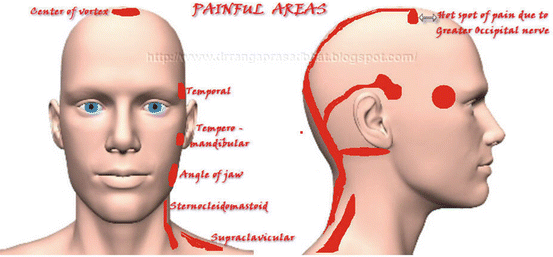Fig. 33.1
Schematic of trigger point complex. Permission from Elsevier
Diagnosis
Currently, there is no accepted gold standard to diagnose a trigger point. The utility of electromyography remains controversial. EMG studies of trigger points reveal spontaneous activity, while adjacent muscle remains electrically silent [4]. Palpatory examination is of paramount importance, as it will help to identify painful foci as well as a potential twitch response. TART is a mnenonic for palpation criteria to help diagnose muscle and somatic dysfunction: Tissue texture abnormality; Asymmetry; Restriction of motion; Tenderness. Usually, trigger points will lie within the muscle belly. When disrupted by palpation, they can lead to reproduction of pain in a specific referred pain pattern (Fig. 33.2).


Fig. 33.2
Head and face trigger points. Permission from Dr. Rangaprasad Bhat
Treatment
Treatment of trigger point-induced pain should be multimodal. Correction of the precipitating factor, along with active and passive physical therapy modalities coincident with TPI have been shown to be most effective. The following modalities are important in the treatment of trigger points: TPI, myofascial release techniques, modalities including heat, ice, ultrasound, and spray and stretch technique, which is the application of flouri-methane or ethyl chloride spray topically followed by active stretching. It is important to ensure that mimickers of trigger point-induced pain are ruled out prior to treatment. These may include, but are not limited to large and small joint dysfunction, systemic arthritides, radicular pain, peripheral nerve compression, tempero-mandibular joint dysfunction, and even visceral pain. It is also important to differentiate trigger point pain from fibromyalgia as both can have superimposing patterns.
The injectate can be a mixture of corticosteroid and local anesthetic or normal saline alone. An anesthetic or normal saline can be used as a solitary injectate as well. Additionally, a variety of other fluids have been used in direct wet needling including vitamin B solutions, acetylsalicylate, ketorolac, and botulinum toxin [3].
Stay updated, free articles. Join our Telegram channel

Full access? Get Clinical Tree





